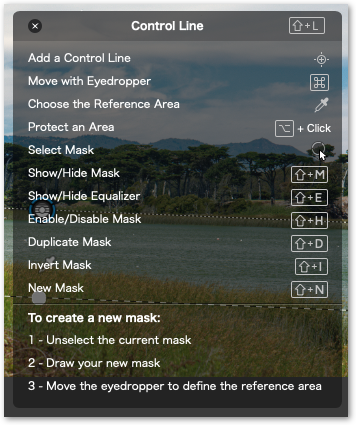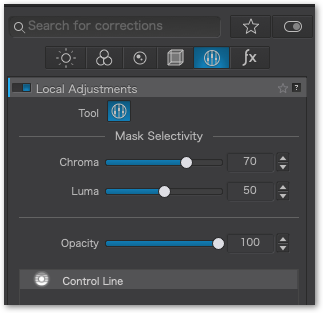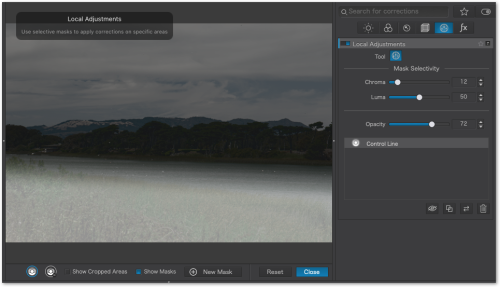C O N T E N T S
•
Photo Corners headlinesarchivemikepasini.com
![]()
A S C R A P B O O K O F S O L U T I O N S F O R T H E P H O T O G R A P H E R
![]()
Enhancing the enjoyment of taking pictures with news that matters, features that entertain and images that delight. Published frequently.
Test Drive: PhotoLab 5



20 October 2021
With PhotoLab 5, DxO complements circular U Point local adjustments with a linear version that resembles Lightroom's gradient filter. Welcome as that new approach is, they didn't leave it at that. DeepPRIME denoising processes data four times faster in this version, metadata gets a little more sophisticated and Fujifilm X-Trans data is now supported.

We attended a briefing earlier this month during which the new features were demonstrated. And we've been testing them ourselves for this review.
NEW FEATURES
The new features, at a glance, include:
- Control Lines and Improved Sensitivity Settings
- Enhanced Metadata Editing, Hierarchical Keywords
- Faster DeepPRIME Denoising
- Fujifilm X-Trans Support Added
SYSTEM REQUIREMENTS
System requirements have gone up a bit this time, too.
Common
- 8-GB of RAM (16-GB recommended)
- 4-GB available disk space (6-GB recommended)
macOS
- Intel Core i7 4th generation or higher recommended or Apple M1
- macOS 10.15 (Catalina), 11.0 (Big Sur) or 12.0 (Monterey)
- Graphics card with 512-MB of video memory for handling GPU acceleration
- AMD Radeon Pro 580x or better recommended for DeepPRIME
Windows
- Intel Core 2 or AMD Athlon 64 X2 or higher (Intel Core i7 4th generation or better or AMD Ryzen recommended)
- Microsoft Windows 10 version 1809 or higher (64-bit and still supported by Microsoft), Windows 10 version 2004 or later recommended
- DirectX 10-capable system
- OpenCL 1.2-capable graphic card with 1-GB of video memory to handle OpenCL acceleration
- NVidia GTX 1060, AMD Radeon RX 5500 or better recommended for DeepPRIME (GPU acceleration is only supported from Windows 10 version 1903)
TEST DRIVE
We installed Catalina on an unsupported 13-inch MacBook Pro with an Intel Core i5 processor, well below specs. And it ran without a hitch. But admittedly this is not a configuration we would recommend, especially the screen size.

Control Lines. Press ? for this helpful display.
We've always been a little sceptical about using U Point's circular spheres of influence for local adjustments. They work, they really do, because they are graduated so the large outer area applies the least effect while the center is strongest. You can overlap them and counter them to protect areas.
But reality is not circular. There are horizons, for example. And fences. And the sides of buildings.
With the new Control Lines that uses U Point technology, you can more cleanly make local adjustments to those shapes.
For our test, we took an image of Lake Merced in San Francisco and optimized it as we would normally do with the Basic editing tools and enabled DeepPRIME for the export even though the image wasn't noisy.
We liked the tonality just fine but wanted to shift the color of the grass growing around the lake itself, which was a little yellow, and the water of the lake, which was a little green. That would have taken multiple Control Points, but it only took one Control Line.

Control Line Masking. We made a few adjustments (in blue on the Equalizer graph) to the lake color. The Control Line anchor is the blue framed circle in the middle of the image. Note the dotted lines running to the edges of the image and the white circle below that with more dotted lines showing the extent of the mask.
Well, that and a slide to the right of the Chroma slider in Mask Sensitivity in the righthand dock to restrict the mask the the color we wanted to adjust.
There is a handy toggle for displaying the mask itself (see below) to help you see what you are affecting. In fact, there's a whole menu of commands to apply to a Control Point or Line, like inverting it.
U Point technology takes some getting used to but its feathered nature makes it a more forgiving approach than more precise traditional masking tools.

Mask Sensitivity. Chroma and Luminance sliders. With Opacity to fade the effect.
Both Control Lines and Control Points now have a Mask sensitivity settings. The panel refers to it as Mask Selectivity. Whatever you call it, it means you can refine the selection made with either the Contol Line or Control Point by adjusting the luminance and chrominance of the selected area.
And the adjustments can be further refined with the Opacity setting, which dampens or fades the effect generated by the mask.
Using that command to toggle the mask display helps make it easier to see how your refinements are affecting the mask. And hiding and unhiding the mask makes it easy to see what your mask is actually accomplishing, too.

Mask Displayed. You can see our Control Line has isolated the foreground and lake.
We spent a good while looking for the sensitivity settings, we have to admit. We kept thinking they would pop up like the U Point help panel (which can't be dragged by its title bar around the screen).
We didn't think of looking in the righthand dock. Only when we referenced our screen shots from the briefing did we uncover the mystery.
You have to select the
U Pointicon to the right of thefxicon in the righthand dock to see them, as you can see in our screen shot above.But you won't have that problem because the Help menu will take you to the online manual where you'll instantly retrieve the answer to this and any other question that pops up. It just wasn't available pre-release, of course.
DxO said the deep-learning approach of DxO PhotoLab 5 and DeepPRIME in particular has been significantly optimized "in terms of reactivity as well as processing and export times." The improvements are "available to everyone and are up to 4 times faster for Apple Silicon Mac users and 1.5 times faster on the best Windows architectures."
Of course they timed that on the M1 chip, not the M1 Pro or M1 Max, which hadn't been announced until after the briefing. The speed increase would be significantly higher on the new chips.
We simply don't have the hardware to tap into the faster DeepPRIME processing speed, but we're glad DxO has been working on it. It's worth the wait, whatever it is, but it would be nice not to have ration it for just a few images. We'd like to think of it as our default.
It was faster, though, even on our i5 CPU. It took 3:18 to export our full resolution image. On our faster i7 machine, the same export in PhotoLab 4 took 5:07.
DxO isn't writing M1 code but its software does run under Rosetta 2. It will be interesting to see what DeepPRIME does on an M1 Pro processor when the company compiles for that chip.
PhotoLab 5 now supports IPTC and EXIF data and third-party application synchronizations. It also supports hierarchical keywording.
If, for example, you have a keyword "Bicycle" which has keywords within it for "English," "French" and "Italian" bikes, by applying "French" to an image, it will also be tagged as "Bicycle."
In addition, the new version optimizes PhotoLab's photo library management tools by reorganizing them.
DxO PhotoLab 5 also introduces support for Fujifilm cameras with an X-Trans sensor. From the recent X-E4, X-S10, X-T4 and X100V to the older X-E2 and X-70, no less than 18 Fujifilm cameras are now supported.
Consequently, 605 new DxO modules have been made available.
Created through DxO Labs' calibration process for both sensors and lenses, these modules automatically remove optical defects like distortion, chromatic aberration, vignetting and lack of sharpness.
The new release adds support for 26 new cameras in total. The full list includes the Canon EOS Ra; DJI Air 2S and Mini 2; Fujifilm X-E2, X-E2S, X-E3, X-E4, X-H1, X-Pro2, X-Pro3, X-S10, X-T1, X-T2, X-T20, X-T3, X-T30, X-T4, X100F, X100T, X100V, X70; Nikon Z fc; Olympus PEN E-P7; Panasonic GH5 II; Pentax K-3 III; and Sony ZV-E10.
PRICE, AVAILABILITY
DxO said PhotoLab 5 would be available today at an introductory price until Nov. 14 of $164.99 (regularly $219) for the Elite version and $109.99 ($139) for the Essential version. Upgrades are similarly discounted to $79.99 ($99) and $54.99 ($75).
CONCLUSION
Control Lines by itself makes this a worthwhile upgrade for U Point enthusiasts. It's about time, after all. And shame on anyone who thought DxO's rewriting of the Google code was just a money-grabbing initiative. It's paying off with the evolution of technology like U Point into tools like Control Lines.
But anyone who admires DeepPRIME will love this release, too. We must be the only clowns to have compared the revised DeepPRIME running on an Intel Core i5 to the older version on an Intel Core i7. But it demonstrates the improvement will be enjoyed by everyone.
And that the update worth all four corners.